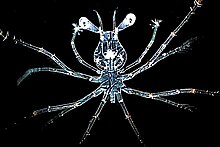Phyllosoma

The phyllosoma is the larval stage of spiny and slipper lobster (Palinuridae and Scyllaridae), and represents one of the most significant characteristics that unify them into the taxon Achelata.[1][2] Its body is remarkably thin, flat, and transparent, with long legs.
The phyllosoma larva of spiny lobsters has a long planktonic life before metamorphosing into the puerulus stage, which is the transitional stage from planktonic to a benthic existence.[3][4] Despite the importance of larval survival to predict recruitment, not much is known about the biology of phyllosoma larvae.[5] In many cases even natural diet is still unclear.[6]

Even though adult morphology is well described, studies on the planktonic phyllosoma phase have been comparatively neglected given its long duration, which has made it difficult to rear them in the laboratory.[7] Despite the relatively large size of these larvae and their immediate recognition in plankton sorting, important identification problems due to the lack of detailed and specific morphological descriptions have precluded specific determination in many plankton samples. Recent efforts to identify phyllosoma larvae using molecular techniques have provided further insight into the ecology and distribution.[8]
See also[edit]
References[edit]
- ^ Gerhard Scholtz & Stefan Richter (1995). "Phylogenetic systematics of the reptantian Decapoda (Crustacea, Malacostraca)" (PDF). Zoological Journal of the Linnean Society. 113 (3): 289–328. doi:10.1111/j.1096-3642.1995.tb00936.x.
- ^ Ferran Palero; Keith A. Crandall; Pere Abelló; Enrique Macpherson; Marta Pascual (2009). "Phylogenetic relationships between spiny, slipper and coral lobsters (Crustacea, Decapoda, Achelata)" (PDF). Molecular Phylogenetics and Evolution. 50 (1): 152–162. doi:10.1016/j.ympev.2008.10.003. PMID 18957325. Archived from the original (PDF) on 2011-10-08.
- ^ David Diaz; Marc Mari; Pere Abello; Montserrat Demestre (2001). "Settlement and juvenile habitat of the European spiny lobster Palinurus elephas (Crustacea : Decapoda : Palinuridae) in the western Mediterranean Sea" (PDF). Scientia Marina. 65 (4): 347–356. doi:10.3989/scimar.2001.65n4347.
- ^ Ferran Palero, Guillermo Guerao & Paul F. Clark (2008). "Palinustus mossambicus Barnard 1926 (Crustacea: Decapoda: Achelata: Palinuridae); morphology of the puerulus stage" (PDF excerpt). Zootaxa. 1857: 44–54. doi:10.11646/zootaxa.1857.1.4.
- ^ Raquel Goñi & Daniel Latrouite (2005). "Review of the biology, ecology and fisheries of Palinurus spp. species of European waters:Palinurus elephas (Fabricius, 1787) and Palinurus mauritanicus (Gruvel, 1911)" (PDF). Cahiers de Biologie Marine. 46: 127–142.
- ^ Jeffs A. (2007) Revealing the natural diet of the phyllosoma larvae of spiny lobster. Bull. Fish. Res. Agen. No. 20, 9-13 (review)
- ^ Jiro Kittaka & Fernando A. Abrunhosa (1997). "Characteristics of palinurids (Decapoda; Crustacea) in larval culture". Hydrobiologia. 358: 305–311. doi:10.1023/A:1003158001020. S2CID 31611892.
- ^ Ferran Palero, Guillermo Guerao & Pere Abelló (2008). "Morphology of the final stage phyllosoma larva of Scyllarus pygmaeus (Crustacea: Decapoda: Scyllaridae), identified by DNA analysis". Journal of Plankton Research. 30 (4): 483–488. doi:10.1093/plankt/fbn012. hdl:10261/16948.
